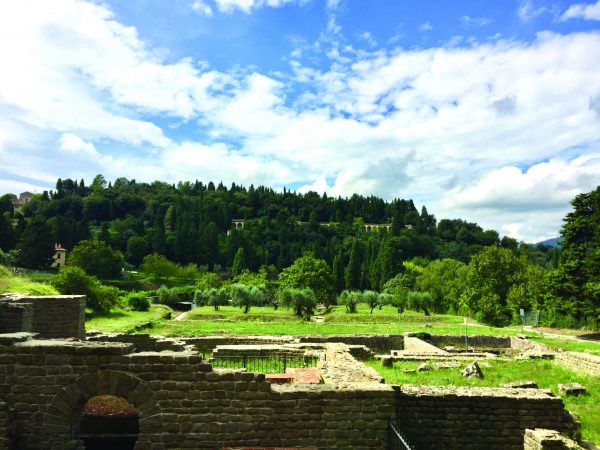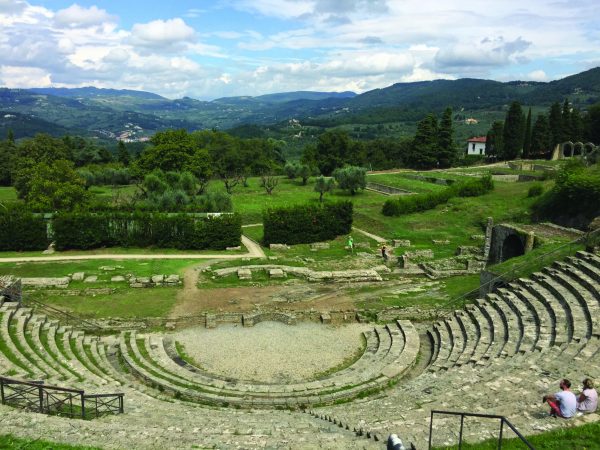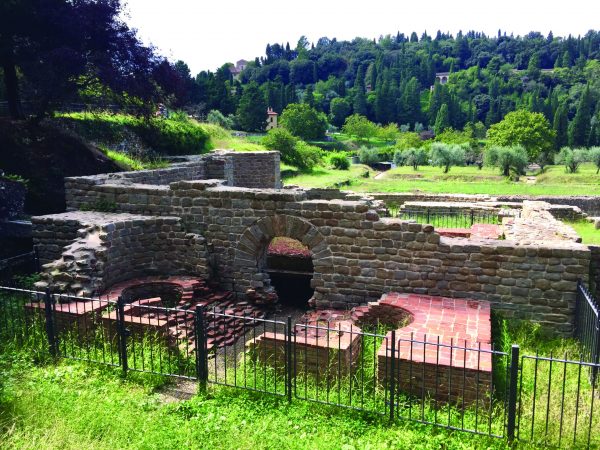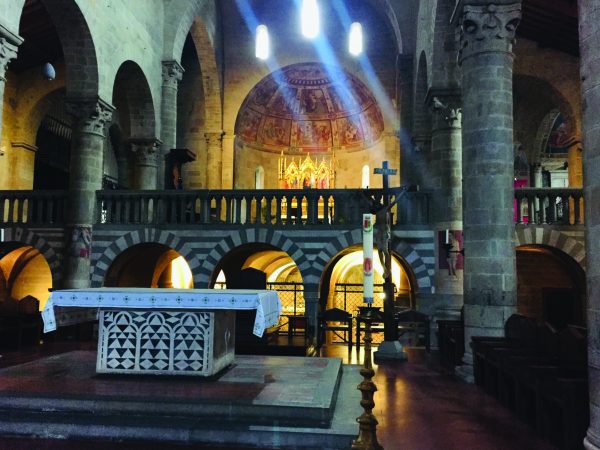Fiesole offers a day away from the bustle of Florence and is well worth exploring when you get there, writes Florence tour guide Freya Middleton.
Images by Freya Middleton
Going to Fiesole is something I have always loved, and I’m not alone. The place has been continuously inhabited and constantly visited by foreigners since the Etruscan era more than 2,500 years ago. The Etruscans built their town on one of the surrounding hills overlooking the valley where, centuries later, the ancient Romans, during the reign of Emperor Augustus, would build Florentia (the original Latin name for Florence) on the flat terrain along the Arno River. This was after they had conquered and colonised the Etruscan city on the hill a few centuries earlier. The Etruscans often built on hilltops but the Romans preferred level ground. The cities are approximately 4km apart, an easy bus ride between them. It’s a place of good vibes!
Archeologically speaking, what we experience today in Fiesole from ancient times is the Roman period. However, if we’re ambitious, traces of the Etruscan fortified city walls can be hunted out. Fiesole is really village-size nowadays, but 2,000 years ago it was a city large enough to sustain a theatre that could hold as many 3,000 spectators. This theatre is now part of the stunning outdoor archeological park museum and can be visited daily by purchasing a ticket. However, every summer, in the evenings for a few weeks, after the ticket office has closed for the day, it is brought to life once again in its true spirit. The Fiesole summer cultural programme hosts concerts to cater for all music lovers, with styles from rock to opera to experimental music, and events are held in the ancient theatre. Florence is hot in the summer, but there is always a slightly lower temperature in Fiesole in the evenings, and possibly even a breeze, which makes for a very agreeable evening in more ways than one!
The theatre is made in the Greek style, which means that it is built into the hill; this was of course due to the geographical limitations of the city. Though there would have once been a high wall behind the stage, no longer extant, the backdrop is now the highly picturesque Tuscan landscape. The theatre was deliberately made north-facing so that the sun didn’t go into the spectators’ eyes.
Behind the theatre archeologists have brought to light other urban sites de rigueur in ancient cities: bases of temples and the ruins of the Roman bath complex, with its three zones for the separate but connected bath pools – hot water (caldarium), warm water (tepidarium) and cold water (frigidarium).
Inside the museum there is a wealth of artefacts on display from the Etruscan, Roman and then Lombardian (Medieval) periods to help colour our picture of how the past residents lived in Fiesole. There is a bar in the museum built with glass walls where refuelling with a coffee or iced tea is incredibly relaxing as you are surrounded by the natural landscape (facing the same way as the theatre) with limited man-made structures and the lush green hills.
GETTING ON THE BUS
I consider a visit to Fiesole really begins from Florence. Bus number 7 begins its route from Piazza San Marco, just north of Florence cathedral. I like to get my seat, sit back and relax into the lovely ride, which will terminate in Fiesole about 30 minutes later. Shortly into the ride, the bus crosses over the eight-lane ring road that encircles Florence, which was the site where, until the mid-1800s, the Medieval high walls of the city stood tall. Beyond this now begin the suburbs of Florence. And the lovely views begin when the bus starts to climb the hill. There are olive groves and large family homes, and with every curve in the road the vista opens up more and more to the landscape of the hills of Florence. The big bus windows lend themselves well to really being able to enjoy the scene. This landscape has inspired artists for centuries and can be seen in the backgrounds of the paintings from the 1400s onwards in the Uffizi.
Halfway up the hill the road briefly flattens as it passes through the tiny village of San Domenico. You’ll notice a lot of people get off the bus here because the EUI (European University Institute) is located here. This is the only European Union funded and founded university, and very astutely they decided on the location of San Domenico for their grounds. They have their core offices in the 1,000-year-old abbey renovated and completely reconstructed in Renaissance style by Michelozzo and paid for by Cosimo the Elder de’ Medici, the unofficial ruler of the Republic of Florence and the head of the great banking house. This was his last great architectural and cultural investment before his death in 1464.
The bus terminates in the Piazza Mino da Fiesole, once the Roman Forum of the city (the central market and business square in ancient times). The cathedral dominates one side of the piazza today; due to the town’s significant importance and population in the medieval period, Fiesole has a cathedral with a bishop. Interestingly, though it has undergone significant changes over the centuries, the structure remains in its original Romanesque form (the artistic period that preceded the Gothic style). It is a large basilica form (rectangular) dividing into three aisles and with an elevated presbytery area. Dedicated to St Romulus, a disciple of St Peter, whose mortal remains are safely tucked away here, there is a fabulous statue of him in tin-glazed terracotta on the counter-façade by the great master Giovanni della Robbia from the early 1500s. Not to be missed is the Salutati Chapel, a Renaissance jewel with sculptural work by the local Renaissance master Mino da Fiesole (the man the piazza is named after). Commissioned by a bishop of Fiesole, Leonardo Salutati, there is his tomb, bust and a bas-relief in the chapel. Mino da Fiesole was one of the early Renaissance masters who expressed a new sensitivity towards expression and form in the human body, reflecting the new Renaissance cultural shift. There is a new nobility in the faces of the people and a sense of self that hadn’t been shown since ancient times.
A BIT OF A CLIMB
Just off that main piazza, running past the very large building of the bishop’s seminary, there is a little road which starts in a very steep ascent from the piazza. Whilst this is a punishing 200-metre climb, the reward is firstly an exceptional view of San Domenico and Florence below, and secondly, a few stone steps later, the church and convent of San Francesco.
Stepping into this exquisite, dark little church from the bright outdoor light always feels magical. The church is small, almost dolllike. Built in 1399, it is in a singleaisle basilica plan, decorated with three wall chapels on each side. The paintings date to the 1400s, from the very early part of that century to its last decade, and includes two masterpieces from master painters Piero di Cosimo and Raffaellino del Garbo. A little door to the right of the church entrance will take you through to the convent, and the spiral stairs lead to the original friars’ cells of the 1400s. There is an ancient sign above the entrance of one, reminding us that one of the most famous Italian preachers from the 15th century, San Bernardino da Siena, briefly lived here.
If you wish to spend the whole day in Fiesole, the Museo Bandini can be added to your itinerary. A stone’s throw from the main piazza (everything is a stone’s throw from the main piazza) are housed some wonderful Renaissance paintings and glazed terracotta works.
A VISIT TO THE PARK
I have always loved walking to the Parco di Montececeri, which is accessed by another of the roads from the piazza. Follow the signs or ask a local which street off the piazza to take and, again after a devilishly steep 100 metres, you are rewarded with stunning views of Florence and beyond. Ten minutes later the wood opens up in front of you. If you have the time and appropriate shoes, follow the red and white painted marks that always signal a walking track in Italy, and roughly one hour later you will arrive at Maiano, the neighbouring hilltop town, where you can lunch at the Fattoria di Maiano and then bus back to Florence from there.
This wood and surrounding area is where much of the Pietra serena (otherwise called Pietra macigno) was quarried. This is the grey sandstone seen all over Florence and was used extensively by Brunelleschi and Michelangelo in their architecture, and this was consequently where many stonecutting families lived. Renaissance masters of sculpture and architecture with names such as Mino da Fiesole or Benedetto da Maiano tells you that they were from humble beginnings because their family name indicates their place of origin. Mino from Fiesole and Benedetto from Maiano were clearly men from working-class stonecutting families who went on to become Renaissance master sculptors and architects.
Leonardo da Vinci also did many a flying experiment with his man-made wings in Montececeri Park and his willing, but unfortunate, assistants! It’s an interesting detour, but if you’re short of time, rather than the climb to Maiano, a short walk into the wood may suffice.
ONE LAST PLACE TO SEE
Instead of catching the bus back to Florence from the main piazza, my last item to add to your itinerary is a walk from the main square down to San Domenico, taking the original road that was once the only link between San Domenico and Fiesole (before the current road was built in the mid-1800s). The Via Vecchia Fiesolana is a very steep road that drops straight down the hill. But this time the walk is all downhill and the views are fantastic!
You will pass Villa Medici, privately owned, which was built in 1450 and was a favourite place for otium (leisure), cultural evenings and humanist Neoplatonic discussions hosted by the Medici family in that period. Fast forward to the early 1900s and it was the childhood home of writer Iris Origo. The garden can be visited upon request, for a small fee. The nearby Villa Le Balze, now the seat of Georgetown University in Tuscany, also boasts a beautiful garden, which can be visited on request, for a small fee, and well worth a quick visit.
Thirty minutes is all it takes to arrive in San Domenico before catching the bus back to Florence. Make sure you have time to step into the San Domenico church with its lovely altarpiece in the first chapel on the left by the great early- Renaissance painter Fra Angelico. The ceiling dates to the early 1700s and is a wonderful cloud swirling glory to Saint Dominic. This was once Fra Angelico’s church and he lived in the monastery next door until the Order was invited by Pope Eugenius IV to move to the monastery in Piazza San Marco in the 1430s. He and his order duly moved from San Domenico to the San Marco monastery, which is conveniently located in the same Florentine square where you got on the bus to start this exciting adventure this morning!
ABOUT THE WRITER
Freya Middleton has a wealth of knowledge about Florence and offers guided tours around the city and beyond. Contact Freya’s Florence Tours.




